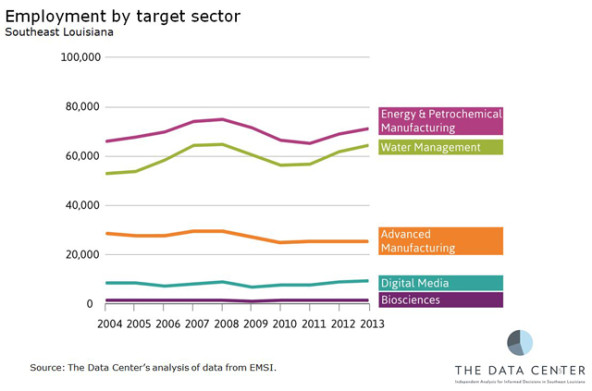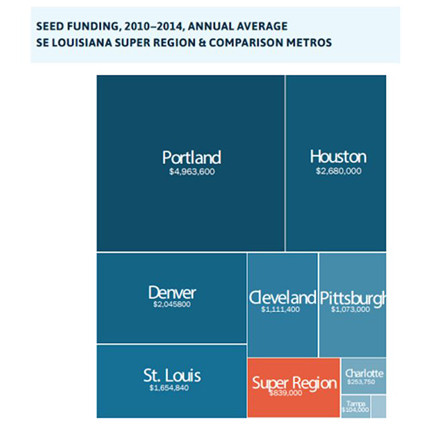It’s no secret that creating and exporting a sustainable way to manage water will be one of the most important and lucrative developments of the 21st century. Water sustains life—but it also presents a tremendous threat. In the coming decades, changing sea level (projected to rise up to four feet during this century) plus more violent storms like Hurricanes Ike, Katrina, and Sandy will likely combine to cause massive flooding in coastal urban centers, wreaking havoc on infrastructure and industry, disrupting utilities, and wiping away entire residential communities. At the same time, worsening droughts throughout the world portend a dry future in which freshwater storage will become increasingly vital.
What may come as a surprise, however, is that New Orleans—a city that knows the destructive power of storm water better than any other—may just turn out to be the hub of water management innovation.
In fact, 10 years after Hurricane Katrina ripped across the Gulf Coast, taking more than 1,800 lives, and five years after the Deepwater Horizon explosion leaked nearly 5 billion barrels of oil into the Gulf of Mexico, Southeast Louisiana is poised to capture the economic opportunity of a lifetime.
Why? Because the area has all the ingredients it needs to build a water management economic cluster—a localized industry including companies large and small that compete, innovate, collaborate, and ultimately export knowledge on a single area of expertise, all while creating well-paying, home-grown jobs for local residents. And doing so could transform the region’s ailing economy into a 21st century powerhouse.
Are you enjoying this article? Read more like this, plus SSIR's full archive of content, when you subscribe.
Consider: Three of the most important factors in identifying an economy with the potential to become a cluster are evident in New Orleans and the surrounding region: existing and future demand, the potential to create many new jobs, and exportability.
Forty percent of Americans—some 123 million people—live in counties directly on the shoreline. Places like Brooklyn, San Francisco, and Norfolk, Virginia, will need tested experts and proven solutions to help protect their residential and business communities from storm surge, flooding, and coastal erosion while increasing the usable water supply.
Meanwhile, the federal government has committed billions of dollars to help protect New Orleans from future flooding and coastal land loss. Up to $10 billion more will flow into Louisiana from oil spill penalties, with about $7 billion of that coming from the recent BP settlement. (This concentrated infusion of funds is reminiscent of the initial federal investment in Silicon Valley through military spending on radio technology. Yes, New Orleans has the opportunity to become the Silicon Valley of water management.) On an urban level, New Orleans is slated to spend billions over the next decade on canals, pumps, and green infrastructure, implementing practices to live with, rather than around, water.
At the same time, Southeast Louisiana has created an additional 10,000 water management jobs since 2010—the largest increase in any job sector in the area (see below). This rapid, concentrated growth gives New Orleans a unique opportunity to build not just lasting infrastructure, but also localized expertise.
 Photos courtesy of the Data Center.
Photos courtesy of the Data Center.
And finally, between 2012 and 2014, Louisiana engineering firms won upwards of $225 million in contracts to aid in Hurricane Sandy restoration efforts on the Atlantic coast. Outside of hurricane relief efforts, Louisiana companies have exported their water management expertise across American coastlines, winning federal contracts in Alabama, Florida, and along the Atlantic coast.
The Caveat
Here’s the catch: Without vital leadership from policymakers, private investors, and philanthropists, this once-in-a-lifetime chance could end up as nothing more than a temporary infrastructure boom. That’s because several of the factors necessary to sustain an economic cluster—factors present in Silicon Valley’s nascent stages—are not yet firmly in place. Workforce education, private capital investment, and local philanthropic support have thus far failed to provide the fuel that will propel the region forward.
Workforce Education
Economists have asserted that investments in human capital are far more important than any other factor for driving economic growth. But Louisiana’s policymakers have cut higher education funding by 42 percent since 2008. The state ranks 45th out of 50 when it comes to students majoring in science and engineering—the precise concentrations that the emerging water management industry will require (see below).
Private Investment
 Photos courtesy of the Data Center.
Photos courtesy of the Data Center.
Support for research and development can also make or break Southeast Louisiana’s chance to transform its economic future. Private investment, especially venture capital, is a leading indicator of cluster growth. But the region pales in comparison to other metropolitan areas in terms of venture funding for local innovation (see below). Coupled with Louisiana’s weak federal and state funding for research and development, this seeming lack of interest in the region from private investment companies is a recipe for stifled innovation and squandered potential.
Philanthropic Support
 Photos courtesy of the Data Center.
Photos courtesy of the Data Center.
Finally, limited philanthropic support for environmental causes such as coastal restoration clouds New Orleans’ economic outlook. Both national and local philanthropy dedicated to New Orleans and the surrounding region has dropped significantly in past years, even though the environmental, economic and cultural damage caused by Hurricane Katrina and the Gulf oil spill is far from repaired. Of the $20 billion American foundations give to various causes, only seven percent is invested in environmental causes. Southeast Louisiana’s local philanthropies score even lower, dedicating just five percent of philanthropic dollars to the environment, despite seeing the impacts of climate change in their own backyards.
Time to Realize the Potential
As we adjust to the new realities of climate change, leaders in coastal cities across the country and around the world will increasingly seek water management expertise. So will the leaders of communities suffering drought. New Orleans can become so much more than just a wonderful vacation spot waiting for its next, inevitable disaster. It can become the hub of water management innovation if leaders in government, the private sector, and philanthropy there recognize and capitalize on the emerging opportunity, and commit to long-term strategies to see it through.
Support SSIR’s coverage of cross-sector solutions to global challenges.
Help us further the reach of innovative ideas. Donate today.
Read more stories by Nihal Shrinath & Allison Plyer.

